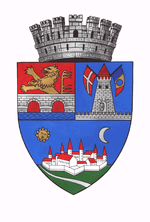Maria Theresia Bastion
| Maria Theresia Bastion | |
|---|---|
 Overview of the Bastion | |
| General information | |
| Town or city | Timișoara |
| Country | Romania |
| Construction started | 1730 |
| Completed | 1735 |
Maria Theresia Bastion (Romanian: Bastionul Maria Therezia) was built between 1730-1735 and is the largest preserved piece of wall of the old citadel of Timișoara. Today it is used as a passage, but it also houses commercial spaces, restaurants, bars, a disco and a library, and two permanent exhibitions of the Museum of Banat, the Information and Communications Technology "Violin - a passion for life", and the Ethnography Museum Village. The bastion is included on the list of historical monuments in the Timiș County with classification code TM-II-m-A-06103.03.
History
After the conquest of Timișoara by the Habsburgs in 1716, it was realized that the fortifications could not cope with new fighting techniques, therefore it was decided to rebuild the whole city in Vauban style (a fortress-stronghold of a stellar shape). It had an area 10 times larger than the Ottoman medieval fortress. The interior was surrounded by three stellar belts that could be filled with water. Access was via three gates: of Vienna, Petrovaradin and Transylvania (completely demolished in 1891). The nine bastions of the fortress were named after kings and queens or generals. In the second half of the 19th century, the majority of the city walls was demolished to make room for the rapidly expanding city.
The Maria Theresia Bastion, named after the Austrian Empress Maria Theresa, was built between 1730-1735 of brick and is the largest defensive wall part of the ancient fortress of Timișoara. It covers about 1.7 hectares of the city center. In addition to this bastion, two other fragments of the walls of the old fortress exist, one of them in the Botanical Park, the other at the Alexandru Ioan Cuza Street.[1]
See also
References
Coordinates: 45°45′25″N 21°14′01″E / 45.756893°N 21.233480°E
